I'm trying to render a pose onto a camera screen with SVG and react-native-vision camera. It works fine on the normal 16:9 aspect ratio but on my friends iPhone Pro Max, which is 19.5:9 then the pose doesn't match up with the body.
It's in the correct shape, just doesn't grow with the body it seems.
Functions for Rending Pose
const [frameWidth, setFrameWidth] = React.useState(Dimensions.get('screen').width);
const [frameHeight, setFrameHeight] = React.useState(Dimensions.get('screen').height);
const getFrameSize = (): number[] => {
let width: number, height: number;
if (Platform.OS === "android") {
if (
frameWidth > frameHeight &&
Dimensions.get("window").width > Dimensions.get("window").height
) {
width = frameWidth;
height = frameHeight;
} else {
width = frameHeight;
height = frameWidth;
}
} else {
width = frameWidth;
height = frameHeight;
}
return [width, height];
};
const getViewBox = () => {
const frameSize = getFrameSize();
const viewBox = "0 0 " + frameSize[0] + " " + frameSize[1];
return viewBox;
};
const renderPose = () => {
if (poses != null && poses.length > 0) {
const selectedJoints = [
poses[0].LeftShoulder,
poses[0].RightShoulder,
poses[0].LeftHip,
poses[0].RightHip,
poses[0].RightKnee,
poses[0].LeftKnee,
poses[0].RightAnkle,
poses[0].LeftAnkle,
poses[0].RightShoulder,
poses[0].LeftToe,
poses[0].RightToe,
poses[0].RightElbow,
poses[0].LeftElbow,
poses[0].RightThumb,
poses[0].LeftThumb,
]
.filter((k) => (k.inFrameLikelihood ?? 0) > 0.3)
.map((k, index) => {
// Flip horizontally on android or when using back camera on iOS.
return (
<Svg >
<Circle
key={`skeletonkp_${k.type}`}
cx={k.position.x}
cy={k.position.y}
r={25}
strokeWidth="2"
fill="transparent"
stroke={Theme.COLORS.WHITE}
/>
{/* <Circle
key={`skeletonkp_${k.type}${index}`}
cx={k.position.x}
cy={k.position.y}
r={10}
strokeWidth="0"
fill="#FAF9F6"
stroke="transparent"
/> */}
</Svg>
);
});
return (
<Svg
viewBox={getViewBox()}
>
{selectedJoints}
</Svg>
);
} else {
return <View></View>;
}
};
Camera component
<PinchGestureHandler onGestureEvent={onPinchGesture} enabled={isActive}>
<Reanimated.View style={StyleSheet.absoluteFill}>
<ReanimatedCamera
ref={camera}
style={StyleSheet.absoluteFill}
device={device}
format={format}
fps={30}
hdr={enableHdr}
lowLightBoost={device.supportsLowLightBoost && enableNightMode}
isActive={isActive}
onInitialized={onInitialized}
onError={onError}
enableZoomGesture={false}
animatedProps={cameraAnimatedProps}
photo={true}
video={true}
audio={hasMicrophonePermission}
frameProcessor={
device.supportsParallelVideoProcessing && isActive
? frameProcessor
: undefined
}
orientation="portrait"
frameProcessorFps={30}
/>
</Reanimated.View>
</PinchGestureHandler>
